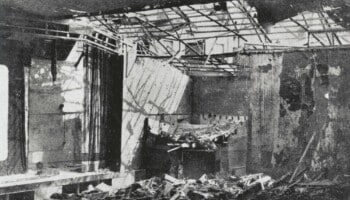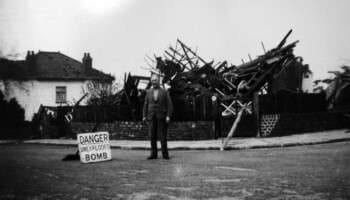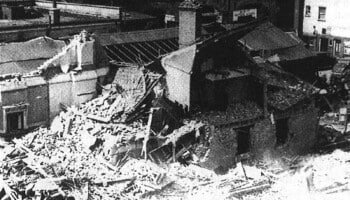Home » Resources » UXO City Guides »
UXO City Guide
Home Office Bombing Statistics for Plymouth
Record of German Ordnance dropped on the County Borough of Plymouth
High Explosive Bombs (All types)
2,584
Parachute Mines
27
Oil Bombs
1
Phosphorus Bombs
190
Fire Pots
18
Pilotless Aircraft (V-1)
0
Long-range Rocket Bombs (V-2)
0
Weapons Total
2,820
Area Acreage
9,525
Number of items per 1,000 acres
296.1
Why was Plymouth targeted and bombed in WWII?
A city steeped in maritime history, Plymouth has long had an association with the Royal Navy and shipbuilding.
During WWII, its deep water Sound offered safe anchorage for large Navy vessels and the fortifications that dot the city’s coastline are testament to the area’s strategic importance. Once the city came into range of German bombers following the fall of France in 1940, the Luftwaffe could easily reach Plymouth from airfields in France and Belgium – and the first bombs fell on the city on 6 July 1940 with the heaviest period of bombing occurring in March and April 1941.
Initially the Luftwaffe heavily targeted HMNB Devonport due to its significant role in the war. Plymouth was not just important for industry and trade but also because it’s the largest naval base in Western Europe.
HMNB Devonport has been supporting the Royal Navy since 1691 and the vast site covered more than 650 acres, with 15 dry docks, 4 miles of waterfront, 25 tidal berths and 5 basins.
The Royal Naval Armament Depot at Bull Point was also targeted due to its large supplies of torpedoes and sea mines – before the Luftwaffe gradually moved away from solely targeting areas of military or industrial importance.
This unrestricted and relentless bombing strategy caused severe damage to large swathes of the dockyards, but also the city’s residential areas and suburbs.
Home Office Bombing Statistics for Plymouth
Details recorded by the official Home Office bombing statistics, indicates the quantity and type of bombs that fell on the County Borough of Plymouth during WWII (excluding incendiary bombs). A total of 2,820 recorded bombs fell in total, an average of 296.1 items per 1,000 acres.
The bomb maps below highlight that the bombing was not restricted to the city’s landmarks and areas of military or industrial importance, with reports of bombs being dropped far out of the city centre.
Local Bomb Maps for Plymouth also show a significant density of bombing in the city’s around the Royal Navy docks.
Major bombing raids in Plymouth
The people of Plymouth experienced their first air raid alert at 12.45am on 30 June 1940, and the first bombs fell in the city just before midday on 6 July 1940. These bombs claimed the first civilian casualties in the city, killing a 33 year old woman, a 58 year old man and a 13 year old boy.
Early attacks were daylight raids conducted against HMNB Devonport, shipping in the Sound, and the shore installations which lined the city’s periphery. Compared to cities further east, Plymouth’s defences were relatively weak. With air cover provided by aging interwar fighters from RNAS Roborough, and the city was vulnerable to enemy bombardment.
The most devastating of the raids on Plymouth occurred during the spring of 1941. On the night of 20th/21st March, the Luftwaffe dropped thousands of Incendiary Bombs In combination with tonnes of High Explosive Bombs, which caused extensive fires and devastation across the city.
During these seven nights alone, over 6,000 general purpose bombs and 205,000 incendiary bombs were dropped on the city. Between July 1940 and April 1944, Plymouth experienced 602 alerts and 59 bombing raids1.
The city experienced mass devastation resulting in the deaths of 1,174 civilians. A further 3,209 were injured, and approximately 4,000 properties were completely destroyed with a further 18,000 damaged or rendered uninhabitable.
The worst of the raids on HMNB Devonport occurred on the nights of April 28th/29th 1941 – when six laboratories, a small arms ammunition store and many other buildings were damaged – and the main office building received a direct hit from a high explosive bomb2.
One of the city’s greatest casualties was Charles Church, a famous landmark that was left gutted by incendiary bombing, and the churches shell was retained as a permanent memorial to the victims of the blitz. Other severe damage included sections of the Laboratory of the Marine Biological Association, St. Andrew’s Church and the Guildhall.
In late April 1941, the Luftwaffe returned causing widespread damage once again. Tragedy struck on the evening of 22nd April when a communal air raid shelter at Portland Square – now part of the Plymouth University campus – took a direct hit and up to 76 people died in the incident3.
Can UXO still pose a risk to construction projects in Plymouth?
The primary potential risk from UXO in Plymouth is from items of German air-delivered ordnance which failed to function as designed. Approximately 10% of munitions deployed during WWII failed to detonate, and whilst efforts were made during, and after the war to locate and make UXBs safe, not all items were discovered. This is evidenced by the regular, on-going discoveries of UXO during construction-related intrusive ground works across the UK – not just in Plymouth.
Occasionally items of British explosive ordnance are also encountered – especially in more peripheral areas of the city, and areas historically utilised by the military such as a number of the parks and former Admiralty land within Devonport.
I am about to start a project in Plymouth, what should I do?
Developers and ground workers should consider this potential before intrusive works are planned, through either a Preliminary UXO Risk Assessment or Detailed UXO Risk Assessment. This is the first stage in our UXO risk mitigation strategy and should be undertaken as early in a project lifecycle as possible in accordance with CIRIA C681 guidelines.
It is important that where a viable risk is identified, it is effectively and appropriately mitigated to reduce the risk to as low as reasonably practicable (ALARP). However, it is equally important that UXO risk mitigation measures are not implemented when they are not needed.
While there is certainly potential to encounter UXO during construction projects in Plymouth, it does not mean that UXO will pose a risk to all projects. Just because a site is located in Plymouth does not mean there is automatically a ‘high’ risk of encountering UXO. It really does depend on the specific location of the site being developed.
A well-researched UXO Risk Assessment will take into account location specific factors – was the actual site footprint affected by bombing, what damage was sustained, what was the site used for, how much would it have been accessed, what were the ground conditions present etc.
It should also consider what has happened post-war – how much development has occurred, to what depths have excavations taken place and so on. This will allow an assessment of the likelihood that UXO could have fallen on site, gone unnoticed and potentially still remain in situ.
Recent UXO discoveries in Plymouth
Since the war, many items of UXO have been discovered across multiple cities within the UK, with Plymouth no exception. See the news articles below about UXO incidents and discoveries from national and local press in Plymouth.
1st Line Defence keep up-to-date with relevant and noteworthy UXO-related news stories reported across the UK, and you can browse through these articles using the buttons below.
Get UXO risk mitigation services from a partner you can trust
UXO City Guides
Got a project in Plymouth? Not sure if there's a UXO risk? Need advice but not sure where to start?
If you need general advice about UXO risk mitigation in Plymouth, contact us and we’ll be happy to help.
Call: +44 (0) 1992 245020 or Email: info@1stlinedefence.co.uk
Contact Us
* indicates required fields







































